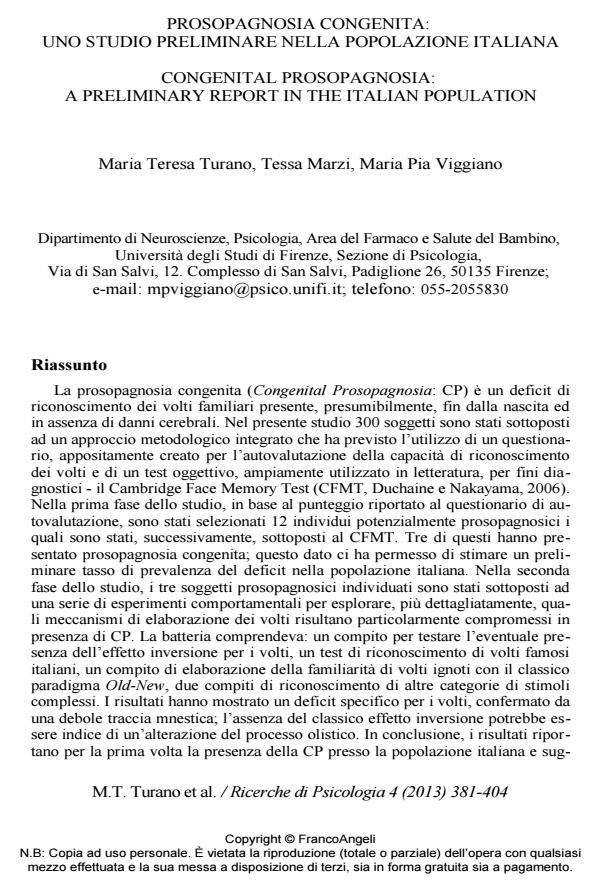Congenital prosopagnosia: a preliminary report in the italian population
Journal title RICERCHE DI PSICOLOGIA
Author/s Maria Teresa Turano, Tessa Marzi, Maria Pia Viggiano
Publishing Year 2014 Issue 2013/4
Language Italian Pages 24 P. 381-404 File size 862 KB
DOI 10.3280/RIP2013-004003
DOI is like a bar code for intellectual property: to have more infomation
click here
Below, you can see the article first page
If you want to buy this article in PDF format, you can do it, following the instructions to buy download credits

FrancoAngeli is member of Publishers International Linking Association, Inc (PILA), a not-for-profit association which run the CrossRef service enabling links to and from online scholarly content.
Congenital prosopagnosia (CP) is a lifelong deficit of face perception and recognition, not caused by brain damage and presumably present from birth. In the first phase of this study, face recognition abilities of 300 subjects were evaluated by using an integrated methodological approach, that involved the employment of a questionnaire, specifically designed for the self-assessment and an objective test, widely used for diagnostic purposes - the Cambridge Face Memory Test (CFMT, Duchaine and Nakayama , 2006). According to the score, we selected 12 potentially prosopagnosics individuals that subsequently underwent the CFMT. Three subjects presented congenital prosopagnosia; thus a preliminary prevalence rate was estimated. In the second phase of the study, the three subjects were tested with some behavioral experiments to explore different mechanisms of perceptual and memory face processing, compared to a healthy control group. The battery included: a task to test the face inversion effect; a recognition test of Italian famous faces; a task to test the familiarity for unknown faces with the classic paradigm Old-New; and finally, two recognition tasks involving non-face stimuli. Our results showed a specific deficit for faces, confirmed by a weaker memory face trace, and the absence of the classic inversion that may indicate an impairment of holistic process. All in all, our results show for the first time the presence of CP in the Italian population and suggest the important use of an integrated methodological approach for the selection of the clinical sample for future studies on CP in the Italian population.
Keywords: Congenital Prosopagnosia, face recognition, holistic processing, face inversion effect.
Maria Teresa Turano, Tessa Marzi, Maria Pia Viggiano, Prosopagnosia congenita: uno studio preliminare nella popolazione italiana in "RICERCHE DI PSICOLOGIA " 4/2013, pp 381-404, DOI: 10.3280/RIP2013-004003